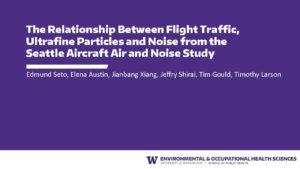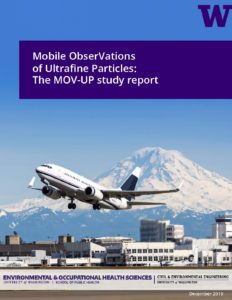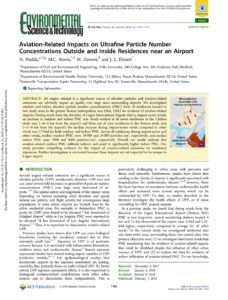The Relationship Between Flight Traffic, Ultrafine Particles and Noise from the Seattle Aircraft Air and Noise Study

Ultrafine particles: unique physicochemical properties relevant to health and disease
Hyouk-Soo Kwon, Min Hyung Ryu & Christopher Carlsten Experimental & Molecular Medicine volume 52, pages318–328 (2020)Cite this article 15k Accesses 98 Citations 82 Altmetric Metricsdetails Abstract Ultrafine particles (UFPs) are aerosols with an aerodynamic diameter of 0.1 µm (100 nm) or less. There is a growing concern in the public health community about the contribution of UFPs to human health. Despite their modest mass
Mobile ObserVations of Ultrafine Particles: The MOV-UP study report
 The Mobile ObserVations of Ultrafine Particles (MOV-UP) study was a two-year project funded by the State of Washington to study air quality impacts ...
The Mobile ObserVations of Ultrafine Particles (MOV-UP) study was a two-year project funded by the State of Washington to study air quality impacts ...
The toxic killers in our air too small to see
Current pollution meters don’t count the very smallest pollutants – nanoparticles. Recent research suggests these tiny toxic substances could be a major cause of illness and death. By Tim Smedley 15th November 2019 A After years of headlines about air pollution, we’ve been misled on a few things about the world’s biggest environmental health problem.
Aviation-Related Impacts on Ultrafine Particle Number Concentrations Outside and Inside Residences near an Airport
 Jet engine exhaust is a significant source of ultrafine particles and aviation-related emissions can adversely impact air quality over large areas surrounding airports. We ...
Jet engine exhaust is a significant source of ultrafine particles and aviation-related emissions can adversely impact air quality over large areas surrounding airports. We ...
2017 Washington State Senate Bill 6032 Sec. 602 (19) MOV-UP Study
“$125,000 of the general fund—state appropriation for fiscal year 2018 and $125,000 of the general fund—state appropriation for fiscal year 2019 are provided solely for the University of Washington school of public health to study the air quality implications of air traffic at the international airport in the state that has the highest total annual
Estimates of HVAC filtration efficiency for fine and ultrafine particles of outdoor origin
Parham Azimi, Dan Zhao, Brent Stephens Department of Civil, Architectural and Environmental Engineering, Illinois Institute of Technology, Chicago, IL, USA Received 31 July 2014, Revised 26 August 2014, Accepted 3 September 2014, Available online 4 September 2014. Abstract This work uses 194 outdoor particle size distributions (PSDs) from the literature to estimate single-pass heating, ventilating, and air-conditioning (HVAC) filter removal efficiencies for